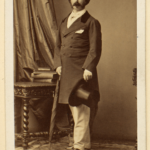
Please note: This item is SOLD.
Click here to see our current stock
Sir Robert Peel
Stock No: 000252
Height: 7.5 Inches / 19 cm
Reference: P.D. Gorden Pugh Staffordshire Portrait Figures, Page B212, Fig 11
A very rare portrait figure of Sir Robert Peel, standing bare-headed, in frock-coat, waistcoat and trousers. His left arm is across his chest and in his hand he clutches a scroll. His right arm is by his side with the wrist flexed and the palm upwards.
This figure was in the late Mr T. Appleton’s collection and has great provenance as it was once part of the Pugh collection and still has the original label to the underside, it is the actual figure that was used for the illustration in P.D. Gorden Pugh’s book, Staffordshire Portrait Figures.
- Some interesting information
A little more information on this fine figure, again fresh to the market and from the collection of the late Mr Appleton.
Sir Robert was twice British prime minister and his period in government saw landmark social reforms and the repeal of the Corn Laws.
Sir Robert Peel was born on 5 February 1788 in Bury, Lancashire. His father was a wealthy cotton mill owner, and Peel was educated at Harrow and Oxford, entering parliament as a Tory in 1809. His early political career included appointments as under-secretary for war and colonies (1809) and chief secretary for Ireland (1812). In 1822, he become home secretary, and introduced far-ranging criminal law and prison reform as well as creating the Metropolitan Police – the terms ‘bobbies’ and ‘peelers’ come from his name.
The Wellington government in which Peel had been home secretary fell in 1830, and Peel was now in opposition to a new administration, headed by Earl Grey. Peel argued passionately against Grey’s proposals for parliamentary reform. Nonetheless, in 1832 the Reform Act was passed.
The Whig Government of Earl Grey was dismissed in 1834 by William IV, who appointed Peel as the new prime minister. In his Tamworth Manifesto, Peel outlined his support for the Reform Act, a shift which highlighted his adoption of a more enlightened Conservatism. Although in power, Peel’s Tories remained a minority in the House of Commons, a situation which Peel found increasingly intolerable, and he resigned in 1835.
In 1841, Peel again formed a Conservative administration, and it was during this government that he oversaw the introduction of significant legislation such as the Mines Act of 1842, which forbade the employment of women and children underground and the Factory Act of 1844, which limited working hours for children and women in factories. In 1845, Peel faced the defining challenge of his career, when he attempted to repeal the Corn Laws which had been introduced to protect British agriculture. This was triggered by the need to free up more food for Ireland, where a potato famine was raging. Landowners resisted in the House of Commons what they perceived as an attack on their interests. Peel’s Conservative Party would not support him, and the debate lasted for months. Eventually, in June 1846, with support from the Whigs and the Radicals, the Corn Laws were repealed. On the same day, Peel was defeated on another bill, and resigned. He never held office again.
Four years later, Peel was badly injured after falling from his horse and died on 2 July 1850 in London.













